In these days we are doing the winter pruning in the vineyard, which is the most important of all the works to direct the vines to a harmonious balance. I will try to make you understand broadly how and why we do this work.
First of all, I would like to emphasize that nothing must be improvised in the winegrower’s work: we rely on a thousand-years peasant knowledge, then deepened by the studies on the physiology of the vine and its relations with the environment around it. Only a good knowledge allows to respect its balance and intervene in a respectful but useful way.
It is important not to make mistakes in the pruning, otherwise we will not be able to produce great terroir-expressive wines. Making a mistake (or making a bad pruning due to lack of skill or lack of competence) has the result of limiting the expression of the full potential of the vineyard and / or damaging it to such an extent as to shorten its life.
[one_third][info_box title=”What happens if the vine is not pruned??” image=”” animate=””]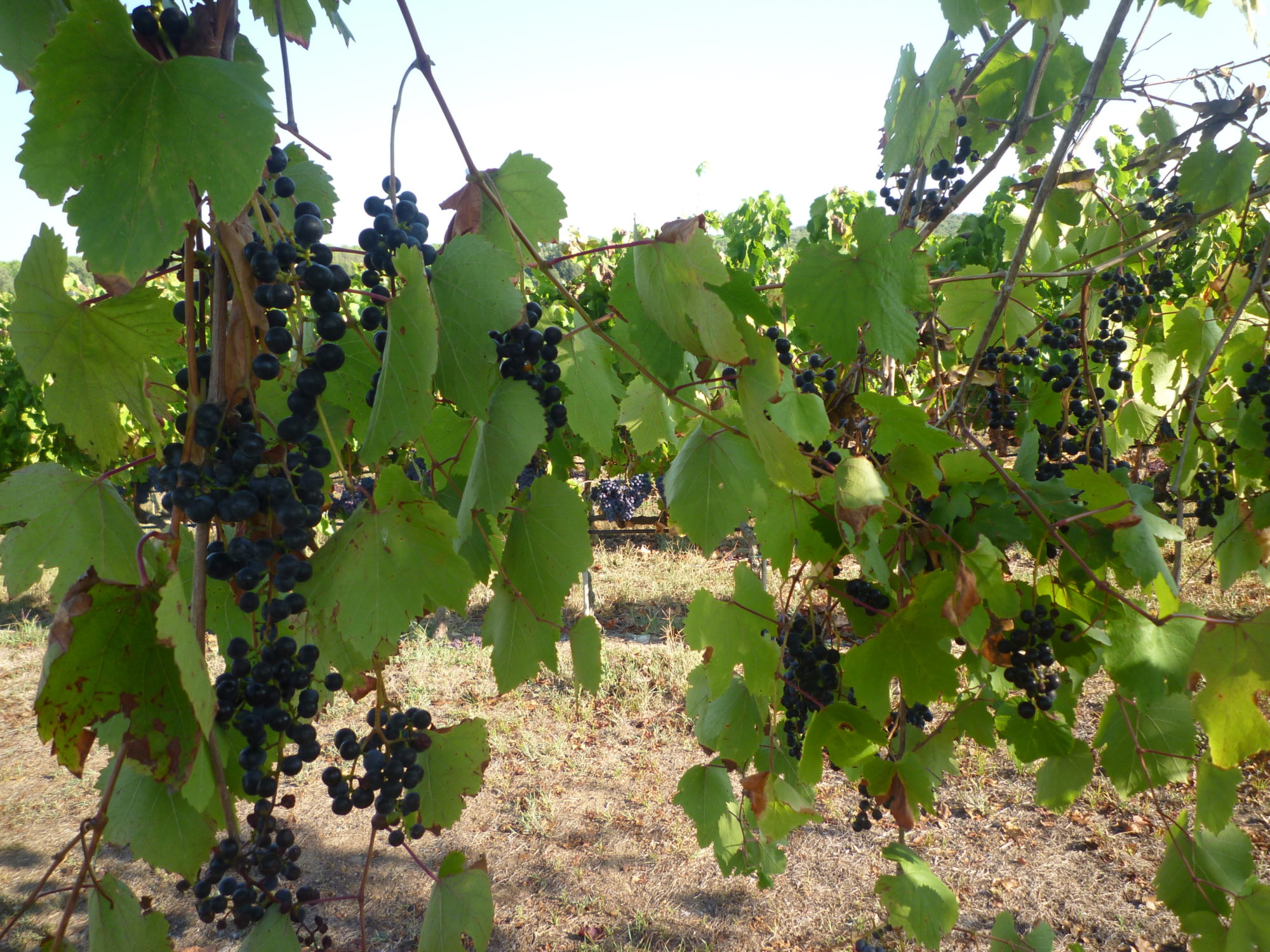
If you do not prune, as happens to wild vines in nature or as it was done in the forms of primitive viticulture, the plant tends to grow a lot and produce many bunches. They are small, not very sweet and not very balanced. It is a grape that is good for feeding wild animals or for making a rudimentary wine.
However, the first winegrowers began to understand with the experience that, by pruning, they managed to produce a better, sweeter grape, and they were able to produce a much more interesting wine. From then on, this practice was no longer abandoned but refined, to the point of becoming almost an art.
The unpruned vine also has a significant production alternation. It means that a year there is an abundant production, the following year instead there will be very little grapes or practically nothing, and so on (beyond the normal fluctuations of the year production, linked to the seasonal trend).[/info_box][/one_third] In practice, when the vine is on dormancy, we cut the branches of the past year, leaving a certain number of buds. This number is carefully evaluated, because it determines the production of the following year. The number and distribution of the buds also define the living space of the plant, that is what is called the vine training system. It is important because it determines the balance between all the parts of the vine (trunk, roots and canopy), in relation to the environment in which it lives.
The cut should be evaluated vine by vine, vineyard by vineyard. It can only be done by hand, by expert people. No choice is random in the good management of the winegrower: if you have the patience to go through with this post, you will understand it.
However, it is not the only work that acts on the overall balance. So, it must be done with an overview, starting with the birth of the vineyard itself, its story over time and already thinking about the subsequent works. Everything must be integrated in the vineyard management.
When pruning:
Pruning is done when the vine is in the winter dormancy phase.
The time of pruning affects that of the spring budding. The sooner you prune and the sooner the vine will sprout (and vice versa). Generally, we winegrowers want to prevent an earlier budding, because there is often a great risk of bad weather at the beginning of spring. There could be frost or hailstorm, which could damage the shoots. For this reason, generally, we prune as far forward as possible. However, it depends a lot on climate: the risk is maximum in northern Italy, minimum in the south (with all the possible intermediate variables). The big risk for our territory is the frost due by the north or north-east winds.
It must also be taken into account, especially for those who are in colder climates, that some varieties bear winter frost less well if they have already been pruned. In this case, it would be better to wait until the coldest period has passed.
Finally, the winemakers have to deal with their own forces and the size of their vineyards, to calculate the exact times. Pruning must be finished, in any case, before the “vine weeping“, i.e. the emergence of droplets from the cutting points of the wood. It is the signal of the restart of the sap circulation in the plant, the first sign of the forthcoming development of the shoots.
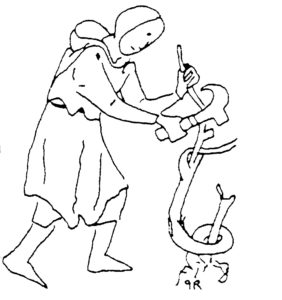
The tools of the pruner.
In the past, the winegrowers used different cutting tools for each region of Italy. The billhook was mainly used in the north. In the center and in the south, different shapes of “pennato” were prevalent (in the drawing: it is similar to a billhook, but with the addition of a second blade. This pruning knife shape dates back to the Roman period). These tools were difficult to wield: it was easy to injury yourself, to injure the plant too much (with the entry of diseases and pests) and it takes strength. In the nineteenth century, the pruning shears (or secateurs) began to be used and the work started to be a little easier. Today we still use them, sometimes electric or pneumatic ones, to reduce fatigue and hand usury. The saw is used only for cuts of particularly large branches, or parts of the trunk.

Pre-pruning is often done for sustainability reasons (as we also do it). It is a very coarse cut of the branches, made with the pre-pruned machine. Then, the pruners will make the handcrafting precise cut. Pre-pruning eliminates the waste of time and the effort to untangle the long branches, wrapped around the wires and between them. Speed is important because, as written, the working time frame is often not very wide.
What do we do with the canes?
As tradition, we break up the branches cut in the vineyard and use them to make compost, useful for recovering organic substance. Someone burn them, but it is not environmentally friendly and it is also a waste. The vegetable compost, which we also do with all the other plant remains (stalks, grass, etc.), contributes to enriching the soil above all with nitrogen, calcium and potassium. The high biodiversity index of our vineyards favors the mineralization of the organic substance and the correct distribution of these nutrients.
Let’s go into detail:
A very delicate and complicated balance

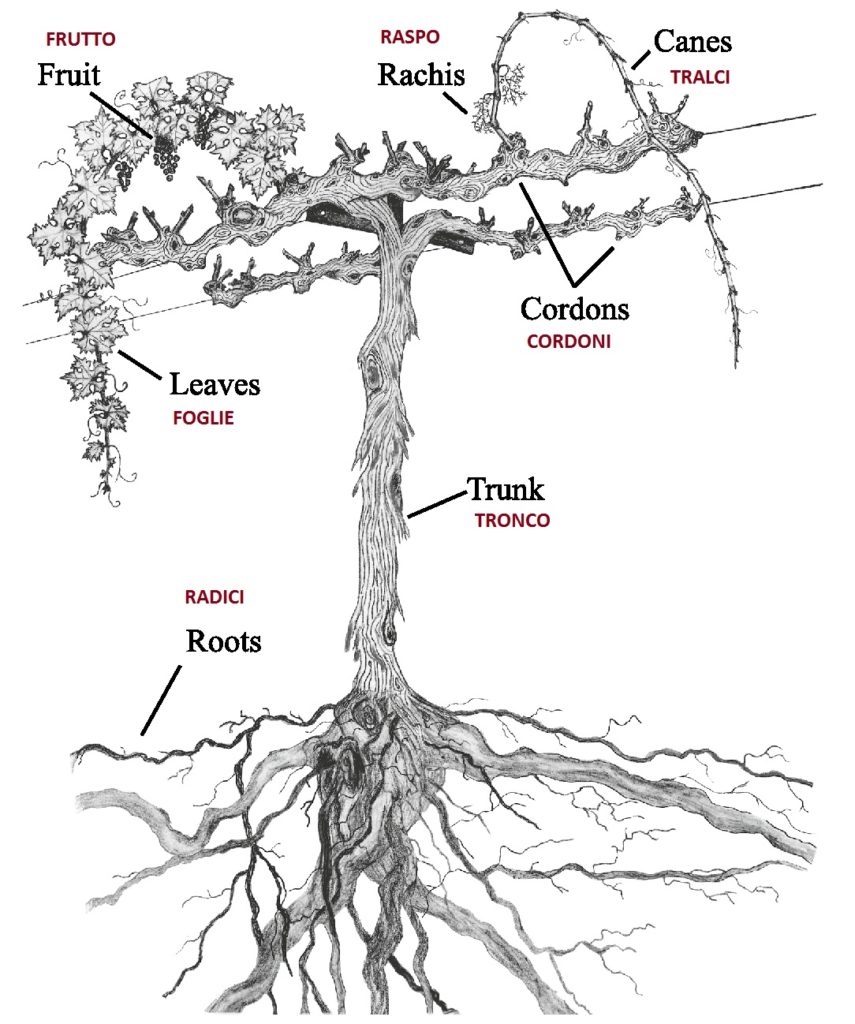
The vine directs its energy to different purposes: the growth of all its parts (woody and green), the formation and development of the bunches, the accumulation of sugars and other organic compounds in the grapes, the storage of reserve substances. All these functions are fundamental for an optimal vine balance (and the vineyard as a whole) so that it grows well, gives good grape and has a long life.
Pruning (with other subsequent works) acts on the regulation of the vigor of the vine, directing its energy first of all to the production of balanced grapes, but it is always necessary preserving a harmonious development of the plant.
The pruning is heavily conditioned by the territory (climate and soil), variety, rootstock, etc. A well-knowledge of these all elements are indispensable to do the optimal choices. Depending on the different conditions, it may sometimes be necessary to stimulate the vigor of the plant, sometimes it is better to limit it.
A too vigorous vine tends to grow a lot in all its parts, producing a lot of grapes, but they will be low-quality. Even a too weak vine will not produce the best wine it could express. It lacks energy and cannot accumulate all the necessary organic compounds in the bunches. Furthermore, it would not feel good in general: it would not be able to carry out the vegetative renewal, to deposit the reserve substances in the perennial organs. This would compromise the balance of the plant, including the optimal work of the roots, with important repercussions on the present and future life of the vine.
In both cases, there would be produced poor quality grapes (for opposite reasons), which will ripen badly. It is not just an unbalanced accumulation of sugars (too many or too few). It will also be a grape that will produce a wine with an unbalanced acidity, which could maintain herbaceous characters, which would not be able to develop aromatic complexity, etc.
[info_box title=”Life cycle and buds” image=”” animate=””]The vine life is a circle: it sleeps in winter, wakes up in spring, sprouts, grows, bears fruit and goes back to sleep. However, it is not a closed cycle: each year it is closely connected to the previous one. The buds that will sprout next spring were formed the year before. They are called dormant or latent buds.
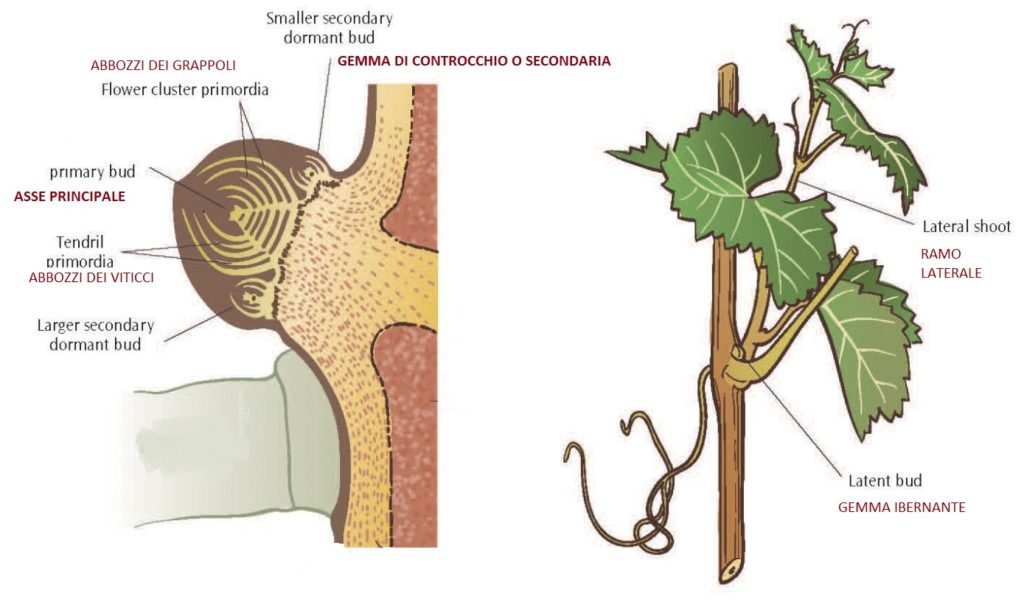
The dormant buds wake up in the spring, sprout and form new canes. Leaves, clusters, tendrils and new buds are born on the internodes of the canes. There are two kinds of buds: the latent and the lateral one. The latter is active in the same vintage in which they are born: it will develop the lateral shoot, during the spring and summer. For now, however, it doesn’t interest us.
If we slice a dormant bud in its birth year and look at it under a microscope, we see that inside there is the primordia of the future cane, on which there are the primordia of the future bunches. Their number indicates the fertility of the bud.
So, do you understand why the more or less good performance of the previous year also affects the production of the next one? Fertility depends on many factors, such as the variety, the vigor of the plant or of the single cane (it grows with the growth of vigor but the two extremes instead, too much or too low, both reduce fertility), etc.
From this microscopic observation, we can also see that there is not only one future cane in the bud. In the center there is one, the largest, called primary bud. There are two other (or one) smaller ones nearby. They are called secondary buds. They are reserves: if the primary bud dies, the secondary ones develop, which are generally not much fertile.
Not all dormant buds, left with pruning, will develop. Some die. Others can remain latent. They are incorporated in the growing wood and can develop even after several years. These secret survival reserves are awakened by particular events, difficult for the vine life (blows, frost, drastic pruning, etc.). When they wake up, they form low, sterile branches, called suckers. In general, the vintners eliminate them with the green pruning. Sometimes they come in handy, because these low canes can be used to reform structural parts of a plant that have been damaged by trauma or pests.[/info_box]
The number of the buds
The number of the buds per vine changes the flow of vigor of the plant.
How many buds to leave with pruning depends on many factors. In general, too high a number of buds would cause an excess of grapes produced. Too low would induce too vigorous growth of the green parts, subtracting energy from the ripening of the bunches. However, it depends a lot on each particular situation: variety, rootstock, climate, soil, density of the vines, previous production, etc.
The best way to understand the optimal number depends only by experience and knowledge. It is necessary to live your own vineyard, make small tests and accurate observations, carried out over the years, which make us understand if we are working well or not.
The vine balance must be as continuous as possible. Excessively drastic changes, even if corrective, can sometimes be more harmful than useful. They alter too sharply a now set balance. For this reason, it is important to evaluate certain changes in an integrated way, considering all the year works in the vineyard.
Short or long pruning?
Another key element of pruning is whether it is done in a long or short way. This depends on the fact that the buds do not always have the same fertility along the cane. It has been known since Roman period, as wrote by Columella. It depends on the climate but also on the varieties.
Why the climate?
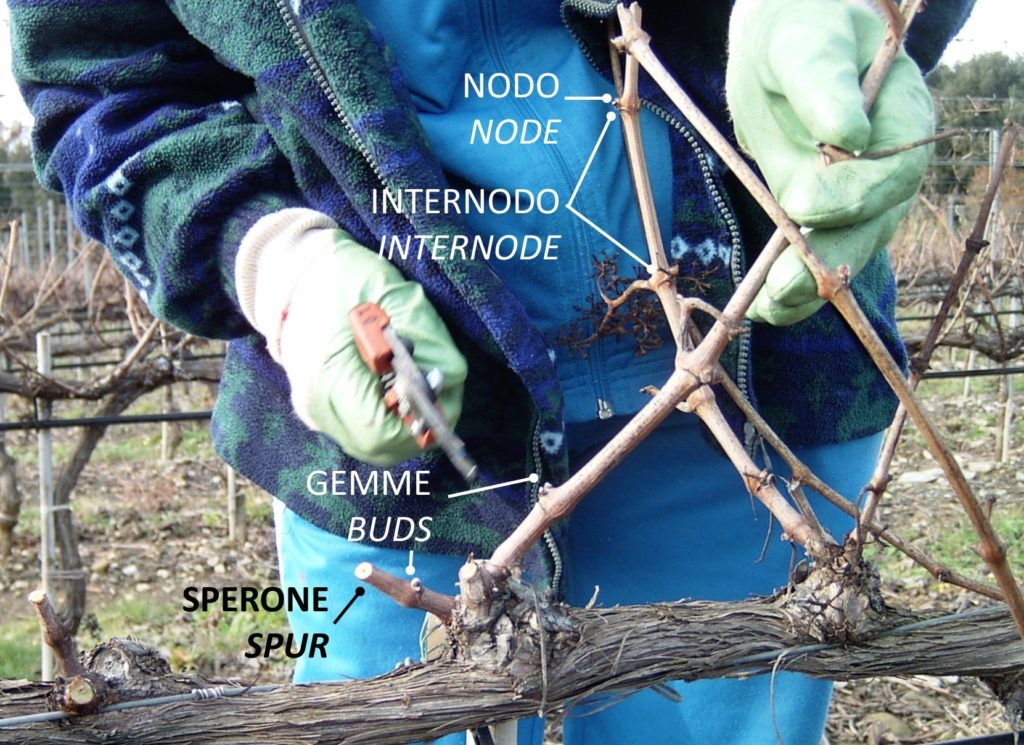
In colder climates, the buds on the first internodes are not complete. They do not form the primordia of the bunches (in scientific terms, they do not well differentiate). They will therefore be little (or not at all) fertile. This happens because they are the first to develop, in early spring. In these climates, this is an unfavorable moment: there are difficult environmental conditions and the plant is weak. The same happens in summer, for the buds of the last internodes. The most fruitful are those that arise in the best moment of life of the plant. They are located in the intermediate part of the cane.
In the warmer territories, as in our case, this usually does not happen. The climate is good from the start, so the buds of the first internodes are also fertile. In this case, it is always better to prune short. A long pruning leave too many fertile buds and too much production would occur.
Some varieties behave differently, regardless of the climate.
Where possible, the winegrowers usually prefer short pruning, which generally gives a better balance between leaves and bunches, with better ripening. In this case, cutting the cane, a short stump remains, called spur.
Long pruning is instead done more frequently in the north Italy, in cooler climates, or it is necessary for some varieties. When we cut, a longer piece of cane remains, with more internodes.
There is also mixed pruning system. In this case, we cut some short and other long canes. It is necessary for certain forms of grapevine training system, when we need to have fruiting branches and to renew the woody parts.
I continue to write “in general” because these aspects are very variable and only experience and knowledge of one’s situation lead to the best choice.
Grapevine training system.
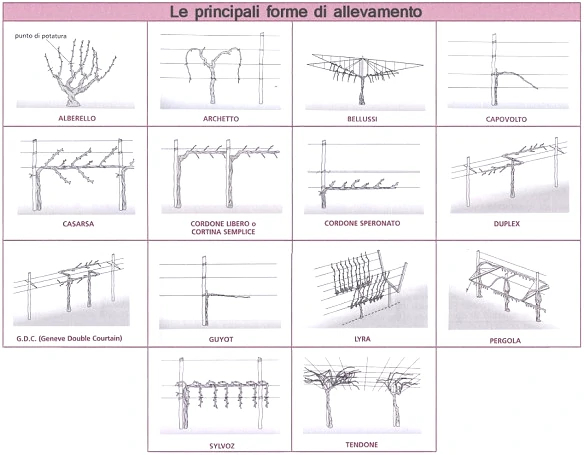
So far, I have described the production pruning. It changes also according to the form of vine growing.
In the first years of life of a vineyard, pruning does not have productive purposes but serves to make the small vine grow well and to take it to the shape of the chosen training system.
How do you choose the training system? It depends on the territory (over all, the climate) and the varieties. In Italy there are many traditional training systems. Each choice is not accidental.
A substantial difference is the height of the trunk of the vine. This element greatly changes the balance of the plant. Inside the trunk, there are vases that carry what is absorbed by the roots (water and mineral salts) and, vice versa, what produced by the leaves (organic substances and energy). The longer the trunk, more energy is lost only for these transfers, subtracting it from the rest. However, there are also different needs, which can make more or less useful to have the trunk higher or lower. For example, where the vigor is not a problem, but there are risks of humidity and frost, it may be more useful to have the trunk high, to distance the bunches from the ground.
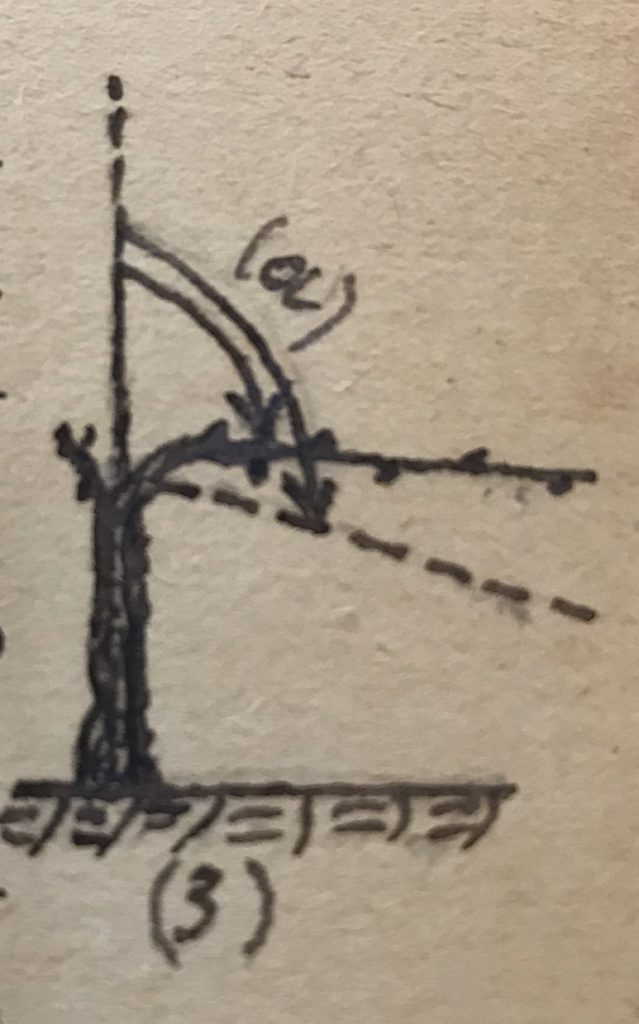
The training system and pruning also affect the arrangement of the canopy. If you notice, there are vineyards with vertical canes, in others they are more or less inclined. Sometimes, they are drooping. This orientation is not accidental. The vegetation activity, the vigor of a cane, is favored by the vertical position. This is generally preferred where there are limiting environmental conditions for the vine. The more the branch is bent with respect to the vertical, the more it loses its vigor. So, it is often found in the territories where you want to counteract too high a vigor. It is a phenomenon that also depends on the complex internal transport of the plant.
There are also training systems where the branches are more or less bundled together, willing to make circles, pergolas, etc. In general, the canes that are too united and overlapped favor the stagnation of humidity, the diseases, limit the absorption of sunlight by the leaves, etc. All these choices depend on the particular situation of the vineyard. For example, in very dry climates, overlapping limits water loss, reducing the transpiration. Where there is little sun, in humid climates, it is better instead to arrange branches and leaves so that they take maximum solar energy, without too many overlaps that favor damp (and therefore diseases and rots). The variables are many.
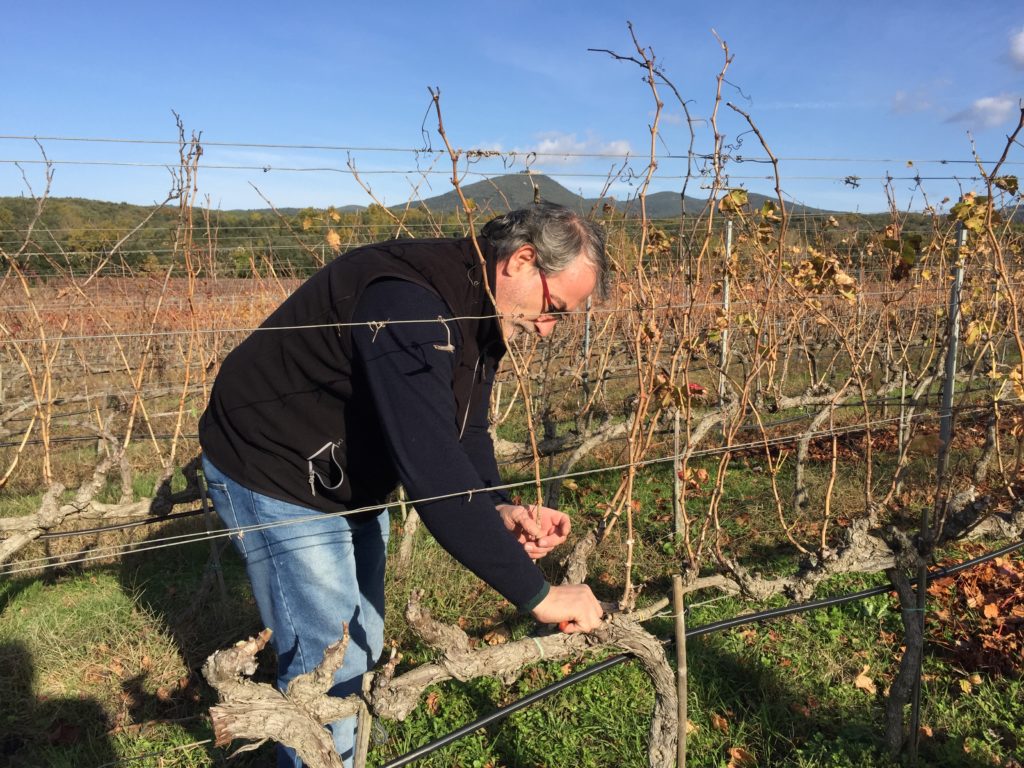
Our training systems and their pruning.
Our climate is mild-Mediterranean, hot and arid in summer, a little rainier in winter and spring. Our alluvial soils are over all lean and well-drained. In this condition, the best grapevine training systems are the low ones, subjected to short pruning, sometimes long (for some varieties), with vertical canopy. We have the Guyot and the spurred cordon.
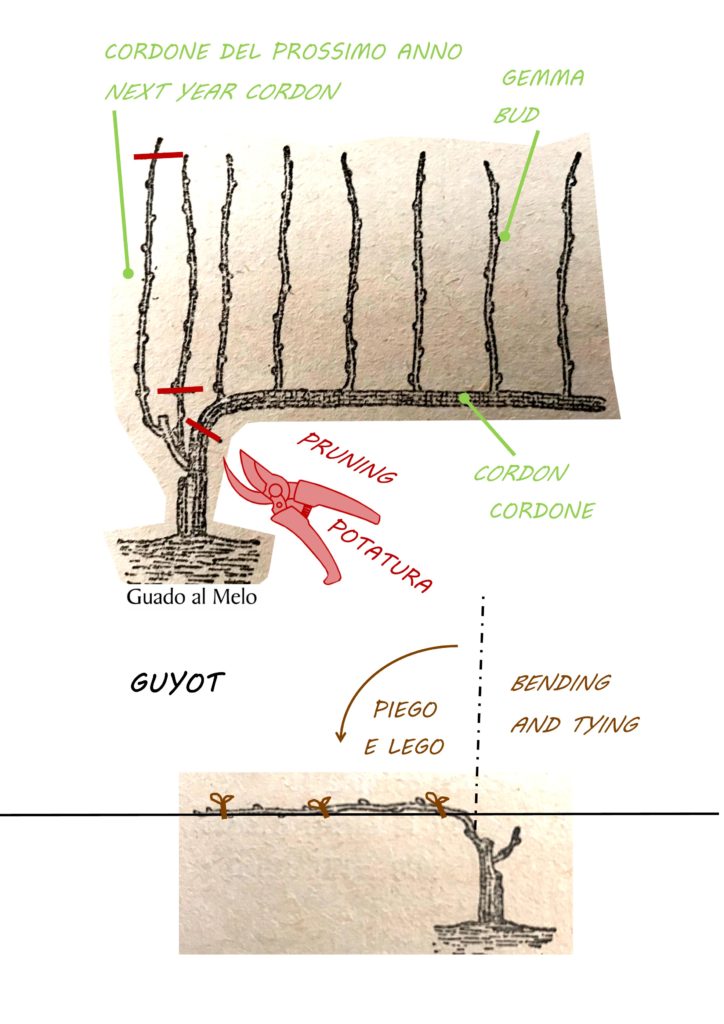 Guyot: it is a very ancient traditional Italian system. It was incorrectly attributed to a French agronomist, Jules Guyot, who described it and spread it in his country in the 19th century. It is a low-production and a high-quality form. It is found in many parts of Italy, from Sicily to Piedmont. It is a mixed pruning system. It is perfect for those varieties that are more fertile in distal buds. It isn’t an expanded form, suitable for not very fertile and drought soils, where the vine generally has a limited development. In the pruning, we cut a long cane, from which the future fruit-bearing canes will develop. A second cane is pruned at spur, which will serve for the next year.
Guyot: it is a very ancient traditional Italian system. It was incorrectly attributed to a French agronomist, Jules Guyot, who described it and spread it in his country in the 19th century. It is a low-production and a high-quality form. It is found in many parts of Italy, from Sicily to Piedmont. It is a mixed pruning system. It is perfect for those varieties that are more fertile in distal buds. It isn’t an expanded form, suitable for not very fertile and drought soils, where the vine generally has a limited development. In the pruning, we cut a long cane, from which the future fruit-bearing canes will develop. A second cane is pruned at spur, which will serve for the next year.
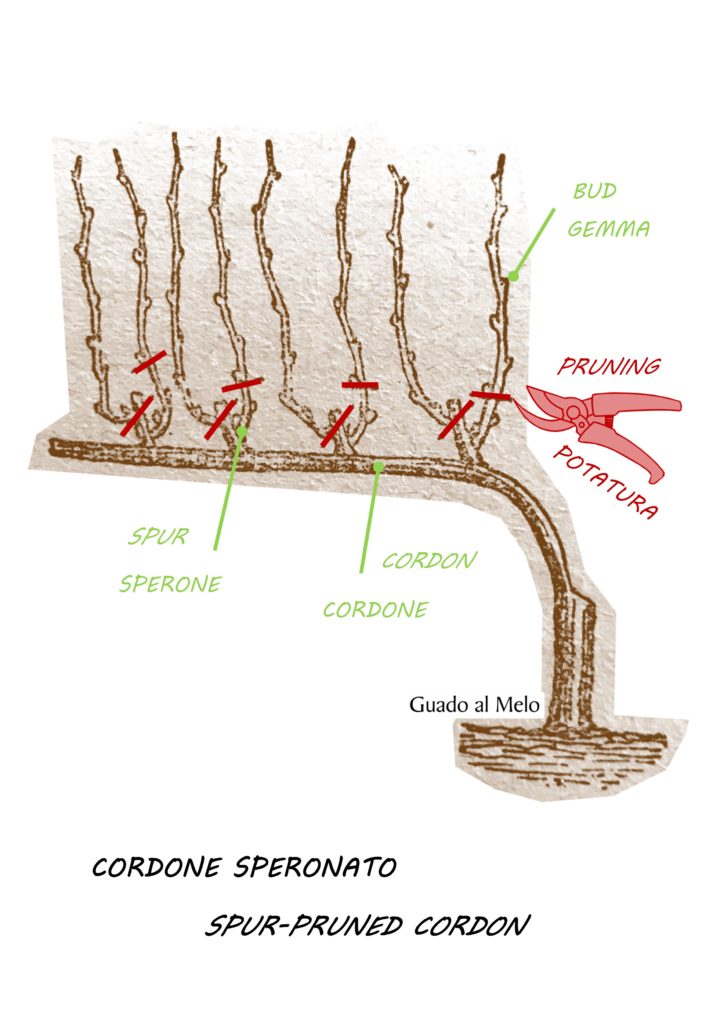 Spurred cordon: it is also traditional and it derives from Guyot. In this case, however, there is only the short pruning. It is suitable for low or medium fertility soils, even dry, and for those varieties that have good fertility on the proximal buds (the first ones). It is frequent in Tuscany and other Italian central regions. During the first years of the vineyard, the best cane is placed horizontally and it becomes a structural element of the plant. The gems on the underside are eliminated. In spring, fruiting canes will form from the upper buds. The following year, each cane will be cut into a spur, forming the cordon. Each subsequent year, it will be cut with short pruning. This system has been successful and has spread due to the excellent quality management of the vineyard, but also for simple and fast pruning.
Spurred cordon: it is also traditional and it derives from Guyot. In this case, however, there is only the short pruning. It is suitable for low or medium fertility soils, even dry, and for those varieties that have good fertility on the proximal buds (the first ones). It is frequent in Tuscany and other Italian central regions. During the first years of the vineyard, the best cane is placed horizontally and it becomes a structural element of the plant. The gems on the underside are eliminated. In spring, fruiting canes will form from the upper buds. The following year, each cane will be cut into a spur, forming the cordon. Each subsequent year, it will be cut with short pruning. This system has been successful and has spread due to the excellent quality management of the vineyard, but also for simple and fast pruning.
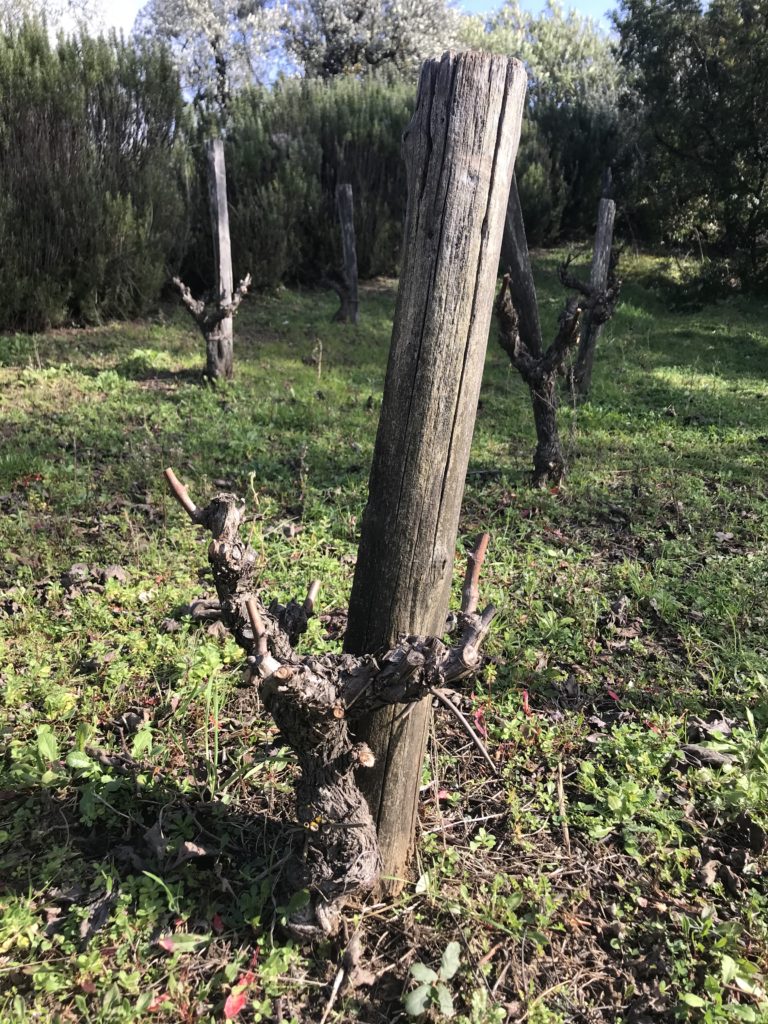
In our historic vineyards we also have:
Head-trained system (In Italian, “alberello”): it is traditional in Italy in the places of ancient Greek or Phoenician culture. It is one of the oldest forms. It is suitable for extremely dry, poorly fertile, or windy or very cold soils, where it is convenient to have a contained vegetation that remains close to the ground. It is at the lowest point of the productivity scale, with the highest sugar levels. It is found in Valle d’Aosta (which is semi-arid) and Sicily, for opposite climatic reasons. Pruning can be very short, as we do (the Greek system, the vites capitatae described by Columella), short or even long or mixed, depending on the territories and varieties.
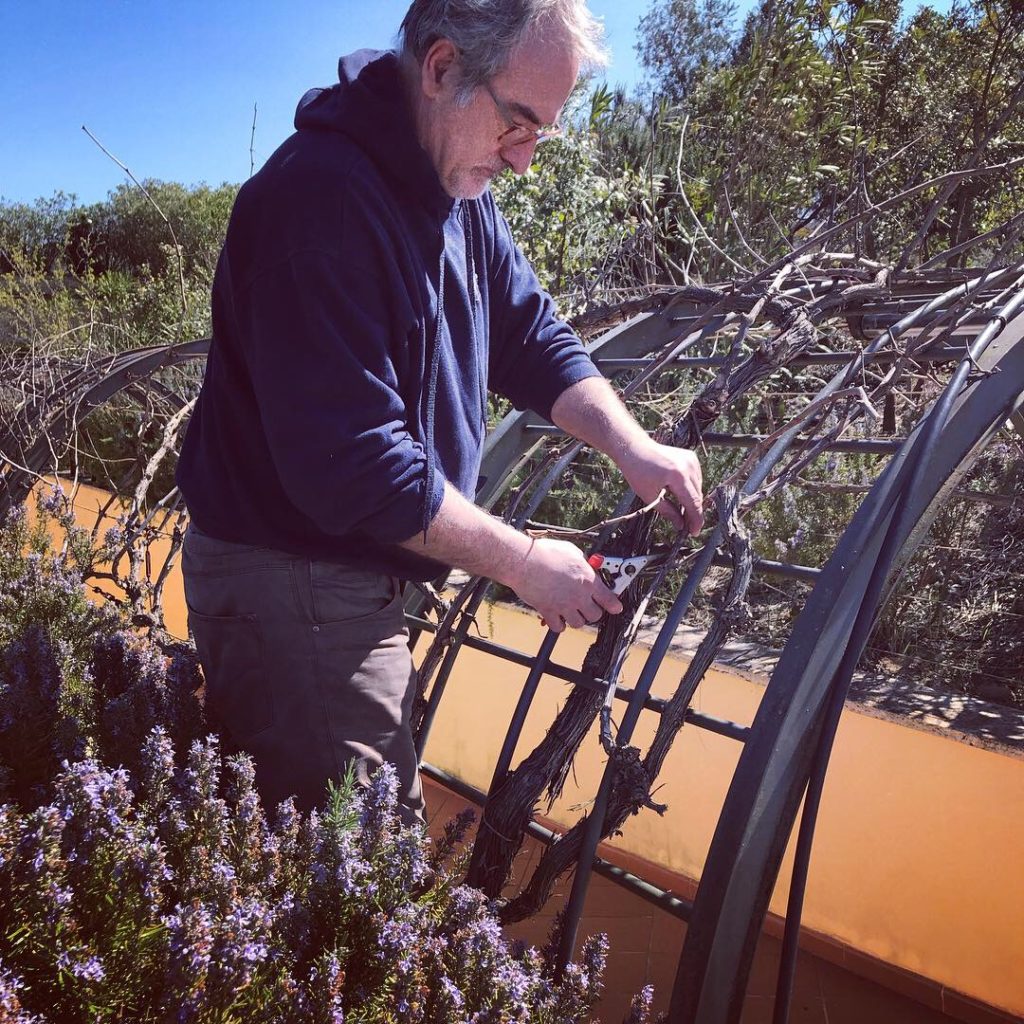
The pergola: the oldest representation is in the Egyptian tombs, where it is represented in the shape of a tunnel, as we have reproduced it at Guado al Melo. In Roman times, horizontal pergolas (called jugatio compluviata) were created to cover avenues and terraces, described by both Columella and Varro. Many variations developed, some more suitable for table grapes, others for wine production. It is a high-vine shape, with the branches well distributed on a more or less inclined surface, to capture the sun’s rays to the maximum, avoid stagnation of humidity, but do not give excessive vigor. In Italy, for wine production, it is widely used in mountain areas, such as Trentino. Pruning can be of different types, depending on the territories and varieties.
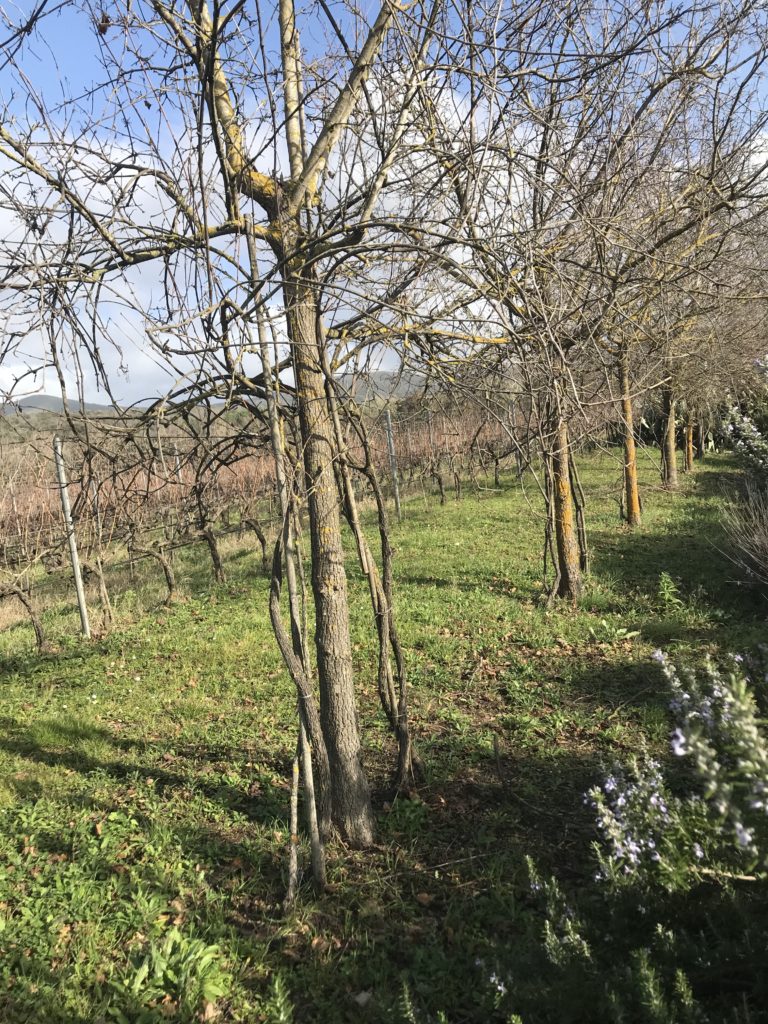
The trained-to-a-tree system or married vine: one of the oldest forms ever, that of our primeval tradition. I have already talked about it at length (here, here and here). It was not pruned at all, in the primitive viticulture. Later and until the twentieth century, it was subjected to long and rare pruning (every two years or even three). It was the system that guaranteed the most longevity of the vine, which frequently became over hundred years old (before phylloxera arrived from America, to complicate the life of the winemakers).